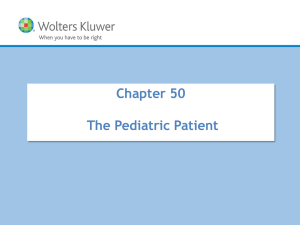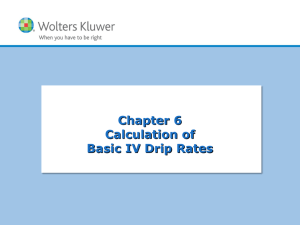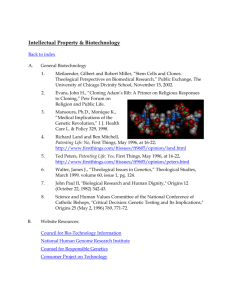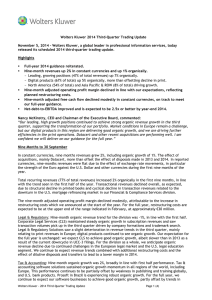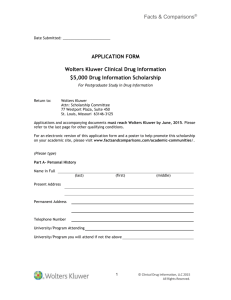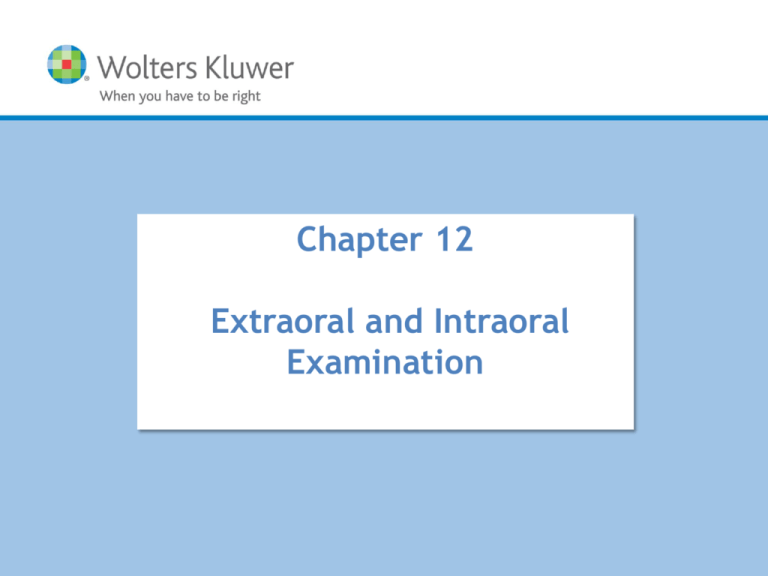
Chapter 12
Extraoral and Intraoral
Examination
Chapter Outline
•
•
•
•
•
•
•
•
•
•
Rationale
Components
Landmarks
Sequence
Morphologic Categories
Oral Cancer
Biopsy Determination
Documentation
Everyday Ethics
Factors to Teach the Patient
Copyright © 2017 Wolters Kluwer • All Rights Reserved
2
Learning Objectives
•
•
•
•
•
Explain the rationale
Explain the systematic sequence
Identify normal anatomy
Describe physical characteristics
Identify suspicious conditions
Copyright © 2017 Wolters Kluwer • All Rights Reserved
3
Rationale For The Extraoral
And Intraoral Examination
•
•
•
•
•
•
•
Early identification
To detect cancer
Thyroid disorders
Eating disorders
Nutritional deficiencies
Sexually transmitted diseases
Systemic conditions
Copyright © 2017 Wolters Kluwer • All Rights Reserved
4
Components of the Examination
• Concept of total patient being treated
• Examination is all-inclusive
– Physical
– Mental
– Psychological
• Routine, thorough examination
• Assessment of health-related risk factors
Copyright © 2017 Wolters Kluwer • All Rights Reserved
5
I. Types of Examinations
• Complete
• Screening
• Limited examination
• Follow- up
• Continuing care/reevaluation
Copyright © 2017 Wolters Kluwer • All Rights Reserved
6
II. Methods for Examination
•
•
•
•
•
•
Visual examination
Palpation
Instrumentation
Percussion
Electrical test
Auscultation
Copyright © 2017 Wolters Kluwer • All Rights Reserved
7
FIGURE 12-1 Bidigital Palpation
Copyright © 2017 Wolters Kluwer • All Rights Reserved
8
FIGURE 12-2 Bimanual
Palpation. A: Examination of
the buccal mucosa by
simultaneous
palpation on extraorally and
intraorally. B: Examination
of the floor of the
mouth by simultaneous
palpation with fingers of
each hand in apposition
Copyright © 2017 Wolters Kluwer • All Rights Reserved
9
FIGURE 12-4 Assessment of the
Temporomandibular Joint
Copyright © 2017 Wolters Kluwer • All Rights Reserved
10
III. Signs and Symptoms
• Signs
• Objective
• Symptoms
• Subjective
Copyright © 2017 Wolters Kluwer • All Rights Reserved
11
IV. Preparation for Examination
•
•
•
•
Review the patient’s histories
Examine radiographs
Patient understanding
Cultural sensitivity
Copyright © 2017 Wolters Kluwer • All Rights Reserved
12
Anatomical Landmarks
Of The Oral Cavity
I. Oral Mucosa
– Masticatory Mucosa
– Lining Mucosa
– Specialized Mucosa
Copyright © 2017 Wolters Kluwer • All Rights Reserved
13
FIGURE 12-6 Anatomical
Landmarks of the Oral
Cavity-Dorsal Tongue
View. A: View of hard and
soft palate. B: View of
uvula and oro-pharynx.
Copyright © 2017 Wolters Kluwer • All Rights Reserved
14
Sequence of Examination
1.
2.
3.
4.
5.
6.
7.
8.
Overall appraisal of patient
Face
Skin
Eyes
Nodes
Glands
Temporomandibular joint
Lips
Copyright © 2017 Wolters Kluwer • All Rights Reserved
15
Sequence of Examination
9. Breath odor
10.Labial and buccal mucosa
11.Tongue
12.Floor of mouth
13.Saliva
14.Hard palate
15.Soft palate, uvula
16.Tonsillar region, throat
Copyright © 2017 Wolters Kluwer • All Rights Reserved
16
FIGURE 12-7 Anatomical Landmarks of the
Oral Cavity-Ventral Tongue View
Copyright © 2017 Wolters Kluwer • All Rights Reserved
17
Lymph Nodes
Copyright © 2017 Wolters Kluwer • All Rights Reserved
18
I. Extraoral Examination
•
•
•
•
•
•
•
•
•
•
•
•
•
. Observe patient during reception and seating to note
physical characteristics and abnormalities, and make an
overall appraisal.
2. Observe head, face, eyes, and neck, and evaluate the
skin of the face and neck.
3. Request the patient remove prosthesis prior to performing
the intraoral examination. Explain how this will
improve the ability to inspect all areas of the mouth
adequately.
4. Palpate the salivary glands and lymph nodes. Figure 12-8
shows the location of the major lymph nodes of the face,
oral regions, and neck. Palpation is a significant component
of the extra-/intraoral examination (Figure 12-9).
Copyright © 2017 Wolters Kluwer • All Rights Reserved
19
I. Extraoral Examination
• Pain or discomfort upon palpation and/or upon
• swallowing.
• Persistent difficulty swallowing in the absence
of pain.
• Any recent noticeable lumps the patient may
have
• experienced without pain.
• Persistent earache or hoarseness of voice.
• Observe mandibular movement and palpate
TMJ
Copyright © 2017 Wolters Kluwer • All Rights Reserved
20
II. Intraoral Examination
Lips & intraoral mucosa
View/palpate lips, labial and buccal mucosa, and
mucobuccal folds.
• Examine and palpate the tongue
• Mucosa of the floor of the mouth.
• Hard and soft palates, tonsillar areas, and pharynx
• Use a mirror
• oropharynx, nasopharynx, and larynx.
6. Note amount and consistency of the saliva and
evidence of dry mouth (xerostomia).
•
•
Copyright © 2017 Wolters Kluwer • All Rights Reserved
21
Documentation of Findings
A. History
B. Location and Extent
C. Physical Characteristics
Copyright © 2017 Wolters Kluwer • All Rights Reserved
22
Morphologic Categories
I. Elevated Lesions
II. Blisterform
I. Vesicle
II. Pustule
III. Bulla
IV. Nonblisterform
I. Papule
II. Nodule
III. Tumor
IV. Plaque
Copyright © 2017 Wolters Kluwer • All Rights Reserved
23
II. Depressed Lesions
• Ulcer
• Loss of continuity of epithelium
• Erosion
• Shallow
• Does not extend through epithelium to
underlying tissue
Copyright © 2017 Wolters Kluwer • All Rights Reserved
24
III. Flat Lesions
• Macule
• Circumscribed
• Not elevated above surrounding skin or
mucosa
• Identified by color
Copyright © 2017 Wolters Kluwer • All Rights Reserved
25
IV. Other Descriptive Terms
•
•
•
•
•
•
•
•
•
•
Crust
Erythema
Indurated
Papillary
Petechiae
Pseudomembrane
Polyp
Punctate
Torus
Verrucous
Copyright © 2017 Wolters Kluwer • All Rights Reserved
26
Oral Cancer
I. Location
II. Appearance of Early Cancer
– Leukoplakia
– Red areas
• Velvety
– Erythroplakia
– Ulcers
– Masses
– Pigmentation
Copyright © 2017 Wolters Kluwer • All Rights Reserved
27
Procedure For Determining when A
Suspicious Lesion requires a biospy
•
•
•
•
Brush cytology
toluidine blue
Diffuse tissue reflectance
laser-induced auto fluorescence
Copyright © 2017 Wolters Kluwer • All Rights Reserved
28
I. Exfoliative Cytology
A. Cytological Smear
B. Liquid-Based Cytology
C. Oral Brush Cytology
Copyright © 2017 Wolters Kluwer • All Rights Reserved
29
II. Spectroscopy
•
Laser-Induced Autofluorescence
– VELscope
• Diffuse Reflectance Spectroscopy
Copyright © 2017 Wolters Kluwer • All Rights Reserved
30
III. Biopsy
•
•
Indications for biopsy
Pathology report
• Class I : Normal
• Class II : Atypical, but not suggestive of
malignant cells.
• Class III: Uncertain (possible for cancer)
• Class IV: Probable for cancer.
• Class V: Positive for cancer
Copyright © 2017 Wolters Kluwer • All Rights Reserved
31
Documentation
•
•
•
•
Every detail of the oral examination
Recommendations for frequency of exam
Review of all lifestyle habits
Progress note of first maintenance appt.
Copyright © 2017 Wolters Kluwer • All Rights Reserved
32
Factors to Teach the Patient
•
•
•
•
•
Guidance and support
Self-examination monthly
Dietary and nutritional influences
Oral cavity reflects general health
Warning signs of oral cancer
Copyright © 2017 Wolters Kluwer • All Rights Reserved
33

